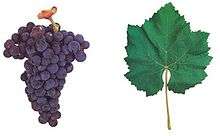Castelão (grape)
| Castelão | |
|---|---|
| Grape (Vitis) | |
 | |
| Color of berry skin | Noir |
| Species | Vitis vinifera |
| Also called | See list of synonyms |
| Origin | Portugal |
| Pedigree parent 1 | Cayetana |
| Pedigree parent 2 | Alfrocheiro Preto |
| Formation of seeds | Complete |
| Sex of flowers | Hermaphrodite |
| VIVC number | 2324 |
Castelão, in Portugal also known as Periquita and João de Santarém, is a red wine grape found primarily in the south coastal regions but is grown all over Portugal and is sometimes used in Port wine production. The name is derived from the Portuguese term for parakeet.
The vine thrives in sandy soils but is able to adapt to a variety of conditions. It produces a wine that can be harshly tannic in its youth but softens as it ages. In the Algarve VR, it is often blended with Negra Mole to produce a wine with less aging potential but less harsh in its youth.[1]
Synonyms
Bastardo Castico, Bastardo Espanhol, Castelana, Castelao Frances, Castelao Real, Casteleao, Castellam, Castellao, Castellao Portugues, Castico, Joao de Periquita, Joao de Santarem, Joao de Santarem Tinto, Joao Mendes, Joao Pinto Mendes, Joao Santarem, Lariao Preto, Mortagua, Mortagua de Vide Branca, Olho de Lebre, Perikvita, Periquita, Piriquita, Piriquito, Pirriquita, Santarem, Santarem Tinto, Trincadeira.[2]
The variety Tinta Amarela is also called Trincadeira, but is not related to Castelão.
See also
References
- ↑ J. Robinson Vines, Grapes & Wines pg 217 Mitchell Beazley 1986 ISBN 1-85732-999-6
- ↑ "CASTELAO". Vitis International Variety Catalogue VIVC. Julius Kühn-Institut - Federal Research Centre for Cultivated Plants (JKI), Institute for Grapevine Breeding - Geilweilerhof (ZR). August 2017. Retrieved 2017-09-23.